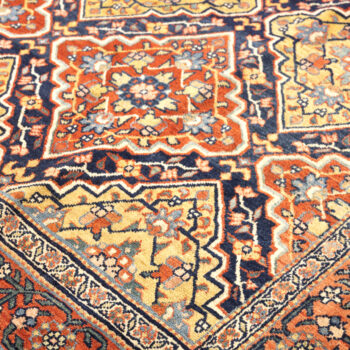Bidjar
Bidjar or Bijar is a city located in the Kurdistan region, in northwestern Persia, not far from Tabriz. The ancient carpets of Bidjar were produced by the Kurds who received orders from the Persian rulers and the nobility for their own use or to be given as gifts.
Bidjar rugs are world famous for their durability and palatial dimensions. They are durable because they are made with a very compact triple weave. All the knots are symmetrical and as the weaver tied each row of knots, she added extra weft and literally beat the knots, causing them to become dense and compact. So Bidjar rugs are very heavy in relation to their size and also bulkier. This extremely firm and heavy structure created greater strength and durability. For this reason, the ancient Bidjar carpets became known as “the iron carpets of Persia”. Given their thickness and the way they are made, they can be difficult to fold. The result of this work: they can last more than 200 years even under intense use.
The elite of Bidjar rugs are called Halvai. Some of the finest pieces of these antique rugs were commissioned by European nobility over the last hundred years. Halvai rugs exceed in their aesthetics and feature asymmetrical designs and the improvised use of colors. Tribal patterns are also found in these rugs. Each family created their own patterns and special details in the rugs they wove.
The design of Bidjar rugs generally varies between geometric and floral which can be spread across the entire area of the rug or around a central medallion. Weavers from the Bidjar region transformed many classic Persian designs into their own interpretations by recreating other designs. Persian carpet designs “Mina khani” and “Herati” (both have identical designs that are repeated throughout the carpet field and are rich in detail) and a diamond-shaped medallion were often used. An anchor-like figure is found on many ancient Bidjars at the ends of the medallion or in the form of pendants.

Ancient Bidjar Halvai

Stylized flower and vine designs are also found in Bidjar rugs. Two particularly rare and sought-after rug designs are known as “Garrus” and “Guli Farang”. Garrus’s design generally employs a field ranging from cobalt blue to indigo blue and over it is a large-scale pattern of arabesques divided by flowering vines. The pattern of ancient Guli Farang, translated as “Foreign Flower”, is also made up of a design that spreads across the entire main field and is believed by many to be a stylized representation of large-sized flowers. On pieces woven before 1900, this motif was usually executed on a dark blue or ivory background.
The rich variety of colors of antique Bidjar rugs, ranging from light green to emerald green, a full range of blue tones and a color spectrum from yellow to fiery red, tomato red or deep terracotta, demonstrates the great skill of the dyers of Bidjar.
The culmination of the best tradition of antique Bidjar rugs occurred around 1900. Pieces produced before this period are considered works of refined art. They have tribal elements in their design and coloring that are not found in any other rug made in the large centers of Persia. Antique Bidjar are highly respected by collectors and lovers of carpet art for their uniqueness, durability and great decorative impact. They are commonly compatible with a wide range of traditional and contemporary decors.

Figalli Oriental Rugs
We do not sell rugs. We bring rare works of art to your home in the form of rugs.
Our services
You are Protected
Copyright © 2023 Figalli Oriental Rugs, All rights reserved. Desenvolvido por Agência DLB – Agência de Marketing Digital em Porto Alegre


